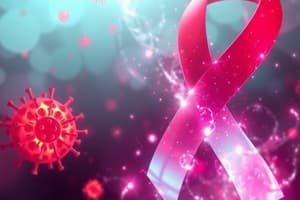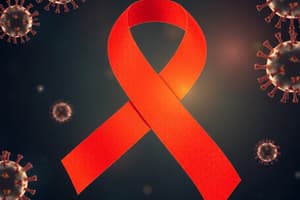Podcast
Questions and Answers
Which of the following best describes immunodeficiency?
Which of the following best describes immunodeficiency?
- A condition where the immune system is weakened, increasing susceptibility to infections and diseases. (correct)
- A condition where the immune system is hyperactive, leading to autoimmune disorders.
- A temporary increase in immune response due to vaccination.
- A state of the immune system being unaffected by external pathogens.
Which of the following is a potential origin of HIV, according to the 'cut hunter hypothesis'?
Which of the following is a potential origin of HIV, according to the 'cut hunter hypothesis'?
- Mutation of the influenza virus.
- Transmission from monkeys through laboratory research.
- Transfer from chimpanzees to humans through hunting and contact with infected blood. (correct)
- Contaminated vaccines administered in the early 20th century.
What defines AIDS (Acquired Immunodeficiency Syndrome)?
What defines AIDS (Acquired Immunodeficiency Syndrome)?
- A genetic disorder causing immune system dysfunction.
- A condition where the immune system is severely damaged by HIV, leading to life-threatening infections and illnesses. (correct)
- An early stage of HIV infection characterized by mild flu-like symptoms.
- The initial seroconversion stage of HIV infection.
During which stage of HIV infection can a person be asymptomatic and still transmit the virus?
During which stage of HIV infection can a person be asymptomatic and still transmit the virus?
What signifies that HIV has progressed to late-stage HIV (AIDS)?
What signifies that HIV has progressed to late-stage HIV (AIDS)?
Which of the following is a common symptom of Non-Hodgkin lymphoma, an AIDS-defining illness?
Which of the following is a common symptom of Non-Hodgkin lymphoma, an AIDS-defining illness?
What is a key characteristic of cryptococcal meningitis in individuals with HIV?
What is a key characteristic of cryptococcal meningitis in individuals with HIV?
Which virus causes Kaposi's sarcoma (KS), an AIDS-defining illness?
Which virus causes Kaposi's sarcoma (KS), an AIDS-defining illness?
What is the primary characteristic of oral hairy leukoplakia, often seen in individuals with HIV?
What is the primary characteristic of oral hairy leukoplakia, often seen in individuals with HIV?
Which statement best describes the rates of 'modifiable' cancer risks among PLWHA (People Living With HIV/AIDS)?
Which statement best describes the rates of 'modifiable' cancer risks among PLWHA (People Living With HIV/AIDS)?
What is the recommendation regarding alcohol consumption for individuals to minimize cancer risks?
What is the recommendation regarding alcohol consumption for individuals to minimize cancer risks?
What is the most common mode of HIV transmission in the UK?
What is the most common mode of HIV transmission in the UK?
Which of the following body fluids is HIV unable to be transmitted through?
Which of the following body fluids is HIV unable to be transmitted through?
Which of the following is considered a risk factor for contracting HIV?
Which of the following is considered a risk factor for contracting HIV?
If you think you may have been exposed to HIV, how long do you have to seek medical advice?
If you think you may have been exposed to HIV, how long do you have to seek medical advice?
What is the purpose of antiretroviral therapy (ART) in the treatment of HIV?
What is the purpose of antiretroviral therapy (ART) in the treatment of HIV?
What does 'undetectable viral load' achieved through HIV treatment typically mean?
What does 'undetectable viral load' achieved through HIV treatment typically mean?
What is the definition of 'viral load' in the context of HIV?
What is the definition of 'viral load' in the context of HIV?
What does the term 'U=U' (Undetectable = Untransmittable) mean in the context of HIV?
What does the term 'U=U' (Undetectable = Untransmittable) mean in the context of HIV?
What does PrEP (Pre-Exposure Prophylaxis) involve?
What does PrEP (Pre-Exposure Prophylaxis) involve?
How soon after potential exposure to HIV should PEP (Post-Exposure Prophylaxis) be initiated to be effective?
How soon after potential exposure to HIV should PEP (Post-Exposure Prophylaxis) be initiated to be effective?
According to statistics from 2019, approximately what percentage of people living with HIV in the UK are estimated to be undiagnosed?
According to statistics from 2019, approximately what percentage of people living with HIV in the UK are estimated to be undiagnosed?
What percentage of diagnosed people with HIV in the UK are virally suppressed?
What percentage of diagnosed people with HIV in the UK are virally suppressed?
When treating a patient who is HIV positive, what measures should be taken within the dental surgery?
When treating a patient who is HIV positive, what measures should be taken within the dental surgery?
Which of the following is a recommended lifestyle change for patients living with HIV?
Which of the following is a recommended lifestyle change for patients living with HIV?
What is the first stage of HIV infection?
What is the first stage of HIV infection?
What is one of the main symptoms of stage 1 HIV infection?
What is one of the main symptoms of stage 1 HIV infection?
How long does Seroconversion illness last?
How long does Seroconversion illness last?
When is someone with HIV at their most infectious?
When is someone with HIV at their most infectious?
After seroconversion, what is the next stage of HIV?
After seroconversion, what is the next stage of HIV?
How long does stage 2 HIV infection last?
How long does stage 2 HIV infection last?
What happens after stage 2 of HIV infection?
What happens after stage 2 of HIV infection?
What risks increase during stage 3 of HIV infection?
What risks increase during stage 3 of HIV infection?
What serious conditions appear during stage 4 of HIV infection?
What serious conditions appear during stage 4 of HIV infection?
What are illnesses known as in stage 4 of HIV infection?
What are illnesses known as in stage 4 of HIV infection?
What is a key function of the lymphatic system?
What is a key function of the lymphatic system?
What is TB caused by?
What is TB caused by?
What is the name for an infection with both HIV and TB?
What is the name for an infection with both HIV and TB?
What is the function of ART medicines?
What is the function of ART medicines?
According to the 'cut hunter hypothesis', how did HIV likely first spread to humans?
According to the 'cut hunter hypothesis', how did HIV likely first spread to humans?
Why might someone infected with HIV in Stage 2 (asymptomatic stage) not realize they are infected?
Why might someone infected with HIV in Stage 2 (asymptomatic stage) not realize they are infected?
What is the significance of illnesses being classified as 'AIDS-defining'?
What is the significance of illnesses being classified as 'AIDS-defining'?
Why is it important to consider Non-Hodgkin lymphoma as a possible AIDS-defining illness?
Why is it important to consider Non-Hodgkin lymphoma as a possible AIDS-defining illness?
How does HIV increase the risk of developing tuberculosis (TB)?
How does HIV increase the risk of developing tuberculosis (TB)?
Why is cryptococcal meningitis particularly concerning for individuals with HIV?
Why is cryptococcal meningitis particularly concerning for individuals with HIV?
How does the herpes virus type 8 (HHV-8) cause Kaposi's sarcoma (KS) in individuals with weakened immune systems?
How does the herpes virus type 8 (HHV-8) cause Kaposi's sarcoma (KS) in individuals with weakened immune systems?
What is a key characteristic of candidiasis that helps distinguish it from other oral conditions?
What is a key characteristic of candidiasis that helps distinguish it from other oral conditions?
What distinguishes oral hairy leukoplakia from other oral lesions?
What distinguishes oral hairy leukoplakia from other oral lesions?
Why should patients living with HIV reduce their alcohol intake?
Why should patients living with HIV reduce their alcohol intake?
What is the significance of knowing that 77% of people in the UK have never had an HIV test?
What is the significance of knowing that 77% of people in the UK have never had an HIV test?
In the context of HIV treatment, what is the main purpose of aiming for an 'undetectable viral load' through ART?
In the context of HIV treatment, what is the main purpose of aiming for an 'undetectable viral load' through ART?
How does Pre-Exposure Prophylaxis (PrEP) work to prevent HIV infection?
How does Pre-Exposure Prophylaxis (PrEP) work to prevent HIV infection?
What is the recommended course of action following a potential occupational exposure to HIV, such as a needle stick injury?
What is the recommended course of action following a potential occupational exposure to HIV, such as a needle stick injury?
The 'cut hunter' hypothesis suggests which of the following about HIV?
The 'cut hunter' hypothesis suggests which of the following about HIV?
Compared to the general American population, what is a notable difference in smoking rates among HIV-positive individuals, according to the 2016 Park et al. study?
Compared to the general American population, what is a notable difference in smoking rates among HIV-positive individuals, according to the 2016 Park et al. study?
In HIV stage 3 (Symptomatic HIV), what causes illness?
In HIV stage 3 (Symptomatic HIV), what causes illness?
In the UK, what percentage of people diagnosed with HIV are virally suppressed?
In the UK, what percentage of people diagnosed with HIV are virally suppressed?
Oropharyngeal candidiasis is the most common opportunistic infections impacting those carrying HIV. What type of infection is it?
Oropharyngeal candidiasis is the most common opportunistic infections impacting those carrying HIV. What type of infection is it?
What is something that you should do to treat a patient in the dental surgery, if they are HIV-Positive?
What is something that you should do to treat a patient in the dental surgery, if they are HIV-Positive?
In terms of age, which group represents the largest percentage of people living with HIV in the UK?
In terms of age, which group represents the largest percentage of people living with HIV in the UK?
According to the 2019 statistics, approximately how many people in the UK are estimated to be living with HIV?
According to the 2019 statistics, approximately how many people in the UK are estimated to be living with HIV?
Which region of the UK has the highest percentage of people living with HIV?
Which region of the UK has the highest percentage of people living with HIV?
Which of the following practices is most important for optimal health for those that are HIV positive?
Which of the following practices is most important for optimal health for those that are HIV positive?
Following a potential exposure, such as a needle stick injury, what is the timeframe for PEP treatment to be most effective?
Following a potential exposure, such as a needle stick injury, what is the timeframe for PEP treatment to be most effective?
Which of the following contributes to a "modifiable" cancer risk for individuals living with HIV?
Which of the following contributes to a "modifiable" cancer risk for individuals living with HIV?
What combination of body fluids is HIV found in from an infected person?
What combination of body fluids is HIV found in from an infected person?
Which of the following scenarios presents the highest risk of HIV transmission?
Which of the following scenarios presents the highest risk of HIV transmission?
Aside from unprotected sex and needle sharing, what is another significant risk factor for contracting HIV?
Aside from unprotected sex and needle sharing, what is another significant risk factor for contracting HIV?
Flashcards
Immunodeficiency
Immunodeficiency
Results in increased susceptibility to infections and cancers.
What is AIDS?
What is AIDS?
Term describing life-threatening infections when the immune system is damaged by HIV.
Seroconversion illness
Seroconversion illness
Short illness after contracting HIV (up to 6 weeks)
Asymptomatic stage of HIV
Asymptomatic stage of HIV
Signup and view all the flashcards
Symptomatic HIV
Symptomatic HIV
Signup and view all the flashcards
Late-stage HIV
Late-stage HIV
Signup and view all the flashcards
Non-Hodgkin Lymphoma
Non-Hodgkin Lymphoma
Signup and view all the flashcards
Tuberculosis (TB)
Tuberculosis (TB)
Signup and view all the flashcards
Cryptococcal Meningitis
Cryptococcal Meningitis
Signup and view all the flashcards
Cachexia
Cachexia
Signup and view all the flashcards
Kaposi's Sarcoma (KS)
Kaposi's Sarcoma (KS)
Signup and view all the flashcards
Candidiasis
Candidiasis
Signup and view all the flashcards
Hairy Leukoplakia
Hairy Leukoplakia
Signup and view all the flashcards
Modifiable cancer risks
Modifiable cancer risks
Signup and view all the flashcards
Common way of getting HIV
Common way of getting HIV
Signup and view all the flashcards
Risk Factors for HIV
Risk Factors for HIV
Signup and view all the flashcards
Post-exposure prophylaxis (PEP)
Post-exposure prophylaxis (PEP)
Signup and view all the flashcards
Treatment for HIV
Treatment for HIV
Signup and view all the flashcards
Viral Load
Viral Load
Signup and view all the flashcards
Pre-Exposure Prophylaxis (PrEP)
Pre-Exposure Prophylaxis (PrEP)
Signup and view all the flashcards
Transmission of HIV infection
Transmission of HIV infection
Signup and view all the flashcards
Study Notes
Immunodeficiency
- Immunodeficiency increases susceptibility to infections, cancers, and diseases that healthy immune systems can typically fight off.
- Types of immunodeficiency include:
- Ataxia-telangiectasia
- AIDS
- Complement deficiencies
- Chediak-Higashi syndrome
- DiGeorge syndrome
- Hypogammaglobulinemia
- HIV
- Job syndrome
- Leukocyte adhesion defects
- Combined immunodeficiency disease
History of HIV Discovery
- In 1983, Luc Montagnier considered a virus as a potential cause.
- Montagnier partnered with Francoise Barre-Sinoussi and discovered a retrovirus in cells from AIDS patients.
Cut Hunter Hypothesis
- The cut hunter hypothesis originated from chimpanzees.
- The chimpanzee version of HIV is called simian immunodeficiency virus (SIV).
- The virus likely transferred to humans who hunted chimpanzees for meat and came into contact with infected blood.
- The mutated version spreads from human to human.
AIDS Defined
- AIDS, or acquired immune deficiency syndrome, describes potentially life-threatening infections and illnesses.
- AIDS occurs when the immune system is severely damaged by HIV.
Stages of HIV
Stage 1: Seroconversion Illness
- This stage involves a short illness after contracting HIV, lasting up to 6 weeks.
- Seroconversion illness can be referred to as the primary or acute HIV infection.
- It may be asymptomatic or present like the flu.
- Individuals are most infectious during seroconversion.
Stage 2: Asymptomatic Stage
- Most people feel fine and experience no symptoms once seroconversion ends.
- This stage can last for several years.
- The virus remains active, infecting cells, making copies, and weakening the immune system.
Stage 3: Symptomatic HIV
- The risk of infections and cancers increases without treatment.
- The weakened immune system struggles to fight these conditions.
- Being ill due to opportunistic infections means a person has symptomatic HIV.
Stage 4: Late-Stage HIV
- Late-stage HIV involves serious opportunistic infections and cancers.
- These illnesses are known as AIDS-defining conditions.
AIDS-Defining Illnesses Examples
- Candidiasis of the esophagus, bronchi, trachea, or lungs (but not oral)
- Invasive cervical cancer
- Coccidioidomycosis, disseminated or extrapulmonary
- Cryptococcosis, extrapulmonary
- Chronic intestinal cryptosporidiosis (lasting >1 month)
- Cytomegalovirus disease or CMV (excluding liver, spleen, or nodes)
- Cytomegalovirus retinitis with vision loss
- HIV-related encephalopathy
- Chronic herpes simplex ulcers or bronchitis, pneumonitis, or esophagitis (lasting >1 month)
- Disseminated or extrapulmonary histoplasmosis
- Chronic intestinal isosporiasis (lasting >1 month)
- Kaposi sarcoma
- Burkitt's lymphoma (or equivalent)
- Immunoblastic lymphoma (or equivalent)
- Primary lymphoma of the brain
- Disseminated or extrapulmonary Mycobacterium avium complex or M kansasii
- Mycobacterium tuberculosis at any site
- Disseminated or extrapulmonary Mycobacterium (other or unidentified species)
- Pneumocystis pneumonia (PCP)
- Recurrent pneumonia
- Progressive multifocal leukoencephalopathy
- Recurrent Salmonella septicemia
- Toxoplasmosis of the brain
- Wasting syndrome due to HIV
Common AIDS-Defining Illnesses
Non-Hodgkin Lymphoma
- Non-Hodgkin lymphoma is a cancer of the lymphatic system.
- Its most common symptom is painless swelling in a lymph node, typically in the neck, armpit, or groin.
Lymphatic System
- The lymphatic system supports the body's immune function, helping protect against infection and disease.
- Its components include lymph vessels, lymph nodes, lymphocytes, lymphatic organs, and lymphatic tissue.
Tuberculosis (TB)
- TB is caused by the bacterium Mycobacterium tuberculosis.
- HIV increases the risk of TB infection.
- Coinfection refers to infection with both HIV and TB.
- People living with HIV (PLHIV) are 19 times more likely to develop TB.
Cryptococcal Meningitis
- Cryptococcal meningitis is caused by the fungus Cryptococcus neoformans.
- Microscopic fungus, breathed in by most people, rarely causes sickness.
- Cryptococcus can stay hidden in the body and later cause cryptococcal meningitis, serious but not contagious brain infection, particularly in people with HIV.
Cachexia
- Cachexia, or wasting syndrome/anorexia cachexia syndrome, is not limited to HIV.
- It is a complex process of sudden loss of mass (weight)
Kaposi's Sarcoma (KS)
- Herpes virus type 8 (HHV-8) causes Kaposi’s sarcoma (KS).
- HHV-8 is common; most people with it do not develop Kaposi's sarcoma.
- The virus spreads through sex, blood, saliva, or perinatal transmission.
- It can cause cancer in those with weakened immune systems or genetic vulnerabilities.
- A weakened immune system allows the HHV-8 virus to multiply.
- The virus alters genetic instructions for cell growth, causing uncontrolled reproduction of endothelial cells, forming tumors.
- It primarily affects endothelial cells lining blood and lymphatic vessels.
- Kaposi's sarcoma be limited to the skin or involve lymph nodes and internal organs.
Candidiasis
- Candidiasis is a fungal infection caused by yeast called Candida.
- It typically affects the bronchi, trachea, lungs, or esophagus.
- Oropharyngeal candidiasis is a common opportunistic infection in individuals with HIV.
- The infection presents as easily removable, curd-like white plaques over raw or bleeding mucosa.
- Predominant symptoms includes a sore mouth and throat.
- Patients with esophageal candidiasis have dysphagia and/or odynophagia.
- Respiratory symptoms include increased phlegm, chronic cough, and hoarseness.
Hairy Leukoplakia
- Oral hairy leukoplakia is triggered by the Epstein-Barr virus.
- It occurs mainly in immunocompromised people like people with HIV.
- Hairy leukoplakia is a warning sign of HIV or a weakened immune system.
- It causes white patches on the tongue, which may cause mild discomfort and taste changes.
- Treatment focuses on the underlying immune issue, such as HIV.
Mental Health
- Those living with HIV/AIDS (PLWHA) face higher rates of modifiable cancer risks.
- Modifiable cancer risks are things that can often be avoided with lifestyle changes like smoking, drinking alcohol, and infection with HPV and hepatitis B and C.
- 54% of HIV positive people included in the study were smokers – around two-and-a-half times higher than the general American population
- 5% of HIV positive people were co-infected with hepatitis B compared to 0.3% of the general population with hepatitis B.
- 26% of the individuals had chronic hepatitis C compared to 0.9% of the general American population.
- 46% of women had HPV infection that could lead to cancer compared to 29% of the general US population.
- 68% of men who have sex with men had anal HPV infection with a risk of leading to cancer, although there were no general population figures available.
- Guidelines state consuming more than 14 units of alcohol each week increases risks of cancer. Increased death rate in HIV+ men who drink more than 13 units of alcohol has been found
Transmission of HIV
- HIV is found in semen, vaginal/anal fluids, blood, and breast milk.
- The most common way of getting HIV in the UK is through having anal or vaginal sex without a condom.
- Anal sex carries the highest risk, especially for the passive partner.
- The chance of getting HIV through oral sex is very low.
- HIV cannot be transmitted through sweat, urine, or saliva.
HIV Risk Factors
- Risk factors of contracting HIV include sexually transmitted infections (STIs), sharing contaminated needles/syringes, unsafe injections/transfusions/transplants, or needle stick injuries.
Diagnosing HIV
- Seek medical advice asap if you think you might have been exposed to HIV.
- If you experience a needle stick, contact occupational health services immediately.
- If the patient is known to have HIV, ask if they would be happy to attend occupational health for blood tests.
- Ask for the patients viral load if they know it
- The only way to find out if you have HIV is to have an HIV test.
Coming into Contact with HIV
- Awareness of PEP needed within 72 hours.
- Negative HIV tests may need repeating at 6, 12, and 24 weeks post-incident.
- Positive tests lead to referral to a specialist HIV clinic for further testing and treatment discussion.
Treatment for HIV
- Antiretroviral medicines (ART) is used to treat HIV.
- ART works by stopping the virus replicating in the body.
- Combination of different medicines taken every day
- The goal of HIV treatment is to have an undetectable viral load.
- Viral load measures the amount of HIV in the blood.
- A test measures how much virus is in the body.
- Measured in copies of HIV per milliliter of blood.
- U=U - 200 copies/ml.
- Low - 10,000 copies/ml.
- High – >100,000 copies/ml.
HIV Prevention
Pre-Exposure Prophylaxis (PrEP)
- Blocks the acquisition of HIV.
- It is prevention choice
- Taken regularly (one tablet per day) or 2+1+1 dosing.
- Use Truvada
Post-Exposure Prophylaxis (PEP)
- Started within 72 hours of exposure.
- It is a 28-day course of ARV drugs.
- WHO recommends use for occupational and non-occupational exposures for adults and children.
- Consists of Truvada and raltegravir.
Ending the Stigma
- There were around 105,200 people living with HIV in the UK in 2019.
- 94% of these people are diagnosed and therefore 6% do not know.
- Around 1 in 16 people living with HIV in the UK do not know that they have the virus.
- 98% of people diagnosed with HIV/AIDS in the UK are on treatment and 97% of whom are virally suppressed which means they can't pass the virus on.
- 69.1% of people are male, and 30.9% are female
- The mode of transmission is
- Heterosexual contact (46.1%), Sex between men (46.4%), injecting drug use (1.9%) and unknown (2.7%)
- 91.5% live in England, 5% scotland and 1.1% Northern Ireland
Considerations in the Surgery
- Do not book at the end of the day, place used items in a separate bag, double glove, refuse to see the patient, ridicule or be derogatory about the patient, or make assumptions
- Do use universal precautions, have a welcoming attitude, treat the patient with dignity and carry out treatment the same as a non-HIV patient.
- Advice given include taking rest, ensuring a optimal and balanced diet, stop smoking, yearly flu prevention jabs, reduce alcohol intake, and ensue optimal oral hygiene
Studying That Suits You
Use AI to generate personalized quizzes and flashcards to suit your learning preferences.




